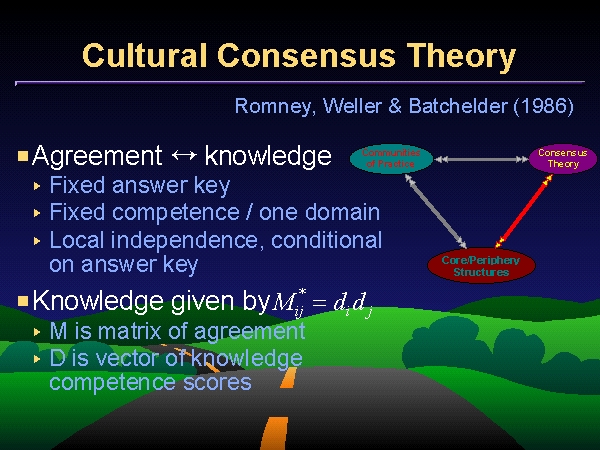Imagine a bustling city square, vibrant with activity. People walk past, each with their own goals and perspectives. Some argue passionately about politics, others share stories over coffee, and children play, oblivious to the world around them. What holds this seemingly chaotic scene together? What creates a sense of shared understanding, even among individuals with wildly different viewpoints? The answer, in part, lies in consensus theory.

Image: www.analytictech.com
Consensus theory, a social science perspective, examines how groups of individuals reach agreement and maintain social order. It posits that social harmony stems from shared values, beliefs, and norms, which act as the glue that binds society together. This theory explores how these collective understandings shape our perceptions, behaviors, and ultimately, the very fabric of our reality.
The Building Blocks of Consensus: Values, Beliefs, and Norms
Shared Values
At the heart of any society lie its shared values. These are the fundamental principles that guide our actions and define what is considered “good” or “bad,” “right” or “wrong.” Take, for example, the value of honesty. This principle guides us to be truthful and transparent in our interactions, fostering trust and ensuring fairness. Values like honesty, justice, equality, and respect form the bedrock of a functional society.
Collective Beliefs
Beyond values, societies also hold common beliefs about the world. These beliefs are often based on shared experiences, cultural traditions, or religious doctrines. While values guide behavior, beliefs shape our understanding of reality. A belief in the benefits of hard work, for instance, can motivate individuals to strive for success, fueling economic growth and social progress.

Image: en.differbetween.com
Social Norms
Norms are the unwritten rules that dictate acceptable behavior within a particular group. These guidelines, often learned through observation and socialization, shape our interactions and maintain social order. Consider the act of shaking hands as a greeting. This seemingly trivial gesture represents a social norm that promotes respect and facilitates smooth interactions. Norms, whether implicit or explicit, are crucial for maintaining social harmony and preventing chaos.
The Power of Consensus: Shaping Our Reality
Consensus theory underscores the powerful influence of shared values, beliefs, and norms in shaping our perception of the world. These collective understandings act like a filter, influencing how we interpret information, make decisions, and engage with our environment. Take, for instance, the concept of “fairness.” A society that values fairness will likely develop legal systems that uphold justice and economic policies that promote equality.
Furthermore, consensus theory highlights the importance of shared understandings in fostering social solidarity. When members of a group share a common vision, they are more likely to cooperate, support each other, and work towards common goals. This strong sense of unity is crucial for addressing social challenges, promoting innovation, and ensuring overall societal well-being.
The Limits of Consensus: Challenging Assumptions and Embracing Diversity
While consensus theory emphasizes the importance of shared understandings, it is crucial to acknowledge its limitations. A rigid adherence to consensus can stifle creativity, innovation, and critical thinking. Moreover, the pursuit of universal agreement can potentially silence minority voices and marginalize alternative perspectives.
A healthy society requires a balance between consensus and dissent. Critical thinking, open dialogue, and the willingness to challenge established norms are essential for social progress and ensuring that everyone’s voices are heard. Recognizing and valuing diversity, including individual experiences and perspectives, is a crucial component of building a more inclusive and resilient society.
Real-World Examples of Consensus Theory at Play
Consensus theory finds real-world applications in various aspects of human society.
- Political Systems: Democratic societies rely on consensus building processes, such as elections and debates, to ensure that government policies reflect the will of the people.
- Legal Systems: Laws are enacted and enforced based on societal consensus regarding what constitutes right and wrong, ensuring a common framework for upholding justice and maintaining order.
- Cultural Traditions: Festivals, rituals, and holidays reflect shared beliefs and values, strengthening social bonds and fostering cultural identity.
- Community Development: Collaborative efforts, such as neighborhood associations or community gardens, thrive on shared goals and a commitment to improving the quality of life for everyone.
The Ongoing Evolution of Consensus
Consensus is not a static concept. It is constantly evolving and adapting in response to changing social circumstances, technological advancements, and global events. The rise of the internet and social media, for instance, has profoundly impacted how we communicate, share information, and forge consensus.
Recognizing the dynamic nature of consensus is essential for understanding contemporary social structures. New challenges, such as climate change, globalization, and technological disruption, necessitate ongoing dialogue and collaborative efforts to build new forms of consensus that are inclusive, adaptable, and responsive to the needs of a changing world.
What Is A Consensus Theory
Conclusion
Consensus theory offers a valuable framework for understanding how societies achieve harmony and maintain order. By examining the role of shared values, beliefs, and norms, we gain a deeper appreciation for the forces that shape our perceptions, influence our decisions, and create the social fabric of our lives. While the pursuit of consensus can be a powerful force for unity and progress, it is equally important to embrace critical thinking, protect individual liberties, and foster a spirit of inclusivity. In a world of diverse perspectives and rapidly evolving challenges, the ability to build consensus remains central to navigating our shared future.






